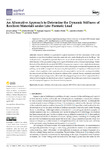An Alternative Approach to Determine the Dynamic Stiffness of Resilient Materials under Low Prestatic Load

Use este enlace para citar
http://hdl.handle.net/2183/38005Coleccións
- Investigación (FIC) [1685]
Metadatos
Mostrar o rexistro completo do ítemTítulo
An Alternative Approach to Determine the Dynamic Stiffness of Resilient Materials under Low Prestatic LoadAutor(es)
Data
2024-06Cita bibliográfica
Carbajo, J.; Poveda, P.; Segovia, E.; Prieto, A.; Río-Martín, L.; Pastor, J.D.; Ramis, J. An Alternative Approach to Determine the Dynamic Stiffness of Resilient Materials under Low Prestatic Load. Appl. Sci. 2024, 14, 4925. https://doi.org/10.3390/app14114925
Resumo
[Abstract]: Dynamic stiffness is a parameter of great importance for the assessment of the sound insulation properties of resilient materials commonly used under floating floors in dwellings. This work proposes a simplified approach that relies on an electro-mechanical circuit model for the determination of this parameter using a two-degree-of-freedom system of masses and springs. Unlike the method described in the standard ISO 9052-1, the proposed approach uses a single electrodynamic actuator both as an impulser and vibration sensor, thus reducing the instrumental requirements and yielding a more stable arrangement. By measuring the input electrical impedance of the mass-loaded actuator when coupled to a slab–material system it was possible to retrieve the mechanical mobility function thereof and thus obtain the dynamic stiffness of the material. Several materials were tested following the proposed approach, with results showing good agreement when compared to those obtained following the standardized procedure. In general, the preliminary research encourages the use of the proposed approach for characterization purposes.
Palabras chave
Dynamic stiffness
Electrodynamic actuator
ISO 9052-1
Electro-mechanical model
Electrodynamic actuator
ISO 9052-1
Electro-mechanical model
Versión do editor
Dereitos
Atribución 3.0 España






